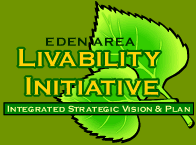LIVABILITY PRINCIPLES

Alameda County’s Eden Area Livability Initiative was launched with the development of a set of Livability Principles identifying regional and local beliefs that will be used as a guideline to develop an integrated approach for future planning, development, land use and service delivery decisions within the urban unincorporated area of the county. It is anticipated that these guidelines will be used as an integrating tool throughout the departments of Alameda County governed by the Board of Supervisors and as a basis to improve cross-jurisdictional coordination among the various agencies not governed by the Board of Supervisors serving the residents of the unincorporated area.
The following documents are provided in Portable Document Format (PDF) and require the free Adobe Reader.
THRIVE Factors of Livability
Place
- What's Sold & How It's Promoted is characterized by the availability and promotion of safe, healthy, affordable, culturally appropriate products and services (e.g. food, books and school supplies, sports equipment, arts and crafts supplies, and other recreational items) and the limited promotion and availability, or lack, of potentially harmful products and services (e.g. tobacco, firearms, alcohol, and other drugs).
- Look & Feel is characterized by a well-maintained, appealing, clean, and culturally relevant visual and auditory environment.
- Safety is characterized by elements that support and enhance a public safety presence through collaborative efforts that promote safe routes throughout the neighborhood, blight removal, adequate lighting, quality of life concerns, and overall community well being.
- Parks & Open Space is characterized by safe, clean, accessible parks; parks that appeal to interests and activities of all age groups; green space; outdoor space that is accessible to the community; natural/open space that is preserved through the planning process.
- Getting Around is characterized by availability of safe, reliable, accessible, and affordable methods for moving people around. This includes public transit, walking, and biking.
- Housing is characterized by the availability of safe and affordable housing to enable citizens from a wide range of economic levels and age groups to live within its boundaries.
- Air, Water & Soil is characterized by safe and non-toxic water, soil, indoor and outdoor air, and building materials. Community design should help conserve resources, minimize waste, and promote a healthy environment.
- Arts & Culture is characterized by a variety of opportunities within the community for cultural and creative expression and participation through the arts.
- Preserve Resources/Natural Terrain is characterized by the preservation of the historical character and resources, natural terrain, drainage, and vegetation of the community.
- Defined Communities are characterized by signage, public art, agricultural greenbelts, wildlife corridors, community gardens and other such unique community elements.
- Public Places are characterized by a design that encourages the attention and presence of people of all ages and interests.
Equitable Opportunity
- Racial Justice is characterized by policies and organizational practices in the community that foster equitable opportunities and services for all. It is evident in positive relations between people of different races and ethnic backgrounds.
- Jobs & Local Ownership is characterized by local ownership of assets, including homes and businesses, access to investment opportunities, job availability, and the ability to make a living wage.
- Education is characterized by high quality and available education and literacy development for all ages.
People
- Social Networks & Trust is characterized by strong social ties among all people in the community - regardless of their role. These relationships are ideally built upon mutual obligations, opportunities to exchange information, and the ability to enforce standards and administer sanctions.
- Participation and Willingness to Act for the Common Good is characterized by local leadership, involvement in community or social organizations, participation in the political process, and a willingness to intervene on behalf of the common good of the community.
- Norms/Expected Behaviors & Attitudes are characterized by community standards of behavior that suggest and define what the community sees as acceptable and unacceptable behavior.
Cross Cutting
- Planning Integrated Communities is characterized by the integration of communities containing housing, shops, work places, schools, parks, libraries, cultural art venues, and civic facilities essential to the daily lives of residents.
- Community Focal Points are characterized by a combination of commercial, civic, cultural, and recreational uses.
- Health Care Access and Treatment is characterized by preventative services, access, treatment quality, disease management, in-patient services and alternative medicine, cultural competence, and emergency response.
*This tool is based on Prevention Institute's Tool for Health and Resilience In Vulnerable Environments (THRIVE) developed to help people understand and prioritize the factors within their own communities in order to improve health and safety. The tool presented here has been modified in particular to incorporate the Eden Area's livability principles.

